Serendip is an independent site partnering with faculty at multiple colleges and universities around the world. Happy exploring!
Bio 202, spring 2008 - notes, April 1 - end

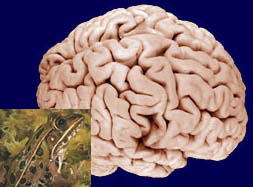
|
Biology 202
|
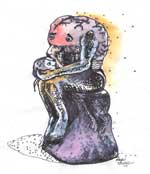 |
1 April
Architecture, from the motor side
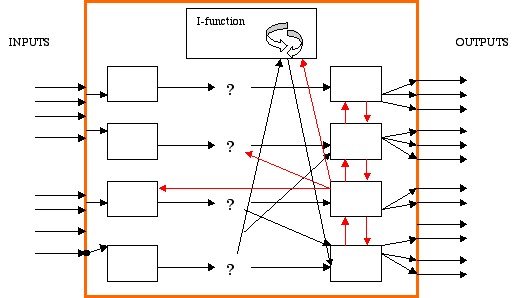
I like thinking about if I did not have an “I” function I would not be sitting here typing these words on Serendip. And I feel like that gives the “I” a lot of power. But, then again, if I did not have CPGs and CD’s and such , I wouldn’t be sitting here typing, either. A wonderful symphony ... merry2e
while sensory signals are no longer sensing inflammation, the corollary discharge expects this degree of inflammation any time it realizes I am standing or am putting weight on my feet, and upon not sensing it, it tells the brain that something is wrong and the brain expresses pain ... it is exciting to think that maybe my feet are healing even though they don't feel like it ... maggie_simon
If we can accept that pain is the nervous system’s method of reconciling corollary discharge information and sensory information, what of emotional tumult? Is there a place in the nervous system where a mismatch between expectation of behavioral output and input coalesce to generate anxiety or sadness, etc ... Sophie F.
At first, i thought the I-function was therefore the conductor mechanism. then, we identified many examples of animal behaviors which were possible without the I-function, so clearly my initial thoughts were wrong. however, now i am left with the notion that the I-function is NOT what controls many of our conscious outputs. this is somewhat disconcerting to me because i do not like to think of the I-function as simply being a box that does not neccessarily have as much control of output (or input) as i previously imagined ...Lyndsey C.
Like many, I too am still unsure about the role of the I-function. Our discussions in class have led me to think that it is not as important as I used to think it was. Prior to this past week, I believed that it was the I-function that conducted most of what we did. I felt that our consciousness was our I-function and because we are conscious for most of what we do, our I-function is the reason for our actions ... I had always viewed choice as being something made consciously ... Rica Dela Cruz
Somethings, you don't order yourself to do. You just do it. Like what Molly said before about locking your keys in the car. You just tend to close the car door after you get out and if I function was really the case, then wouldn't you have been able to stop yourself before locking yourself out of the car? The line seems so hazy and so complicated, I feel that I'm constantly questioning even my own thoughts ... jchung
in thinking about the I-function, it seems to me that it's only role is to over-complicate things. We have yet to come across its definitive role in the NS; rather it seems to move in and out of activity as it pleases. Clearly, it's not entirely necessary for survival. What then, is the value of having an I-function, anyway? ... nasabere
The idea that I-function is not necessary for decision making does not entirely convince me that it is completely irrelevant to the process ... Emily Alspector
Can personal responsibility and neuroscience coexist? ... Caroline Feldman
Central pattern generators
Corollary discharge signals
Reaffent loops
Distributed interactive system, capable of
- coordinated activity without a conductor
- coordinated activity without input ("will"?)
- different outputs with for same input ("choice"?)
- producing its own input
- all without an "I-function"?
- what else can these things do?
- where/what is the "I-function"?
Getting it less wrong, exploring/learning/science without the I-function
| Linear science | Seriously loopy science |
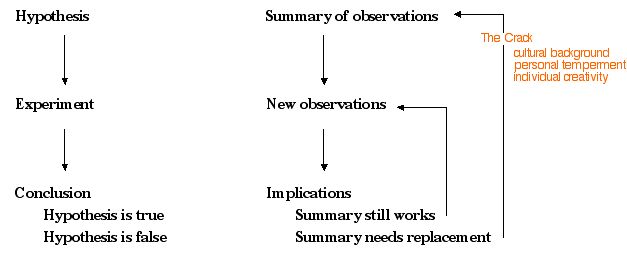 |
|
Adaptation in the vestibulo-ocular reflex and saccadic eye movements
In search of the I-function
Many more boxes/tracts relevant to output side of nervous system (alternate)
Cerebellum, basal ganglia as "loops"
- Cerebellum and "motor learning" (without the I-function)
- Motor imagery (the I-function without action)
Focus on motor cortex
- Somatotopy (topographic organization) - "upper motoneurons"?
- frogs don't have motor cortex - not needed for movement?
- decerebrate rigidity, spastic paralysis
- human
- cat
- three-toed sloth
Role of motor cortex?
- inhibition
- fine motor control, exploration?
- "voluntary/involuntary movement" distinction - with/without "I-function"?
Recapitulation: (looking back)
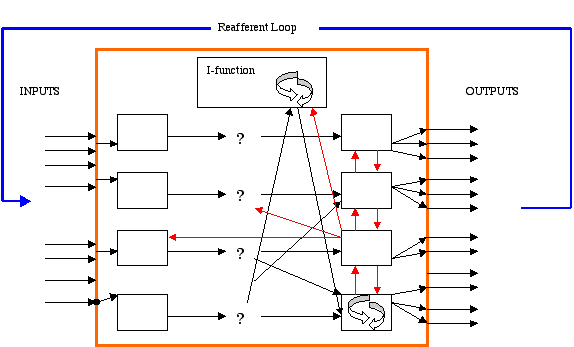 |
 |
Lessons learned "from the output side":
- There ain't nothing there but neurons (ion flows, permeability changes, transmitters ...), interconnections among neurons, information processing
- Action = motor symphony = spatio-temporal pattern of activity across lots of motoneurons
- Symphonies may be based on internal scores and/or afferent/reafferent signals (usually both)
- Symphonies may reflect prior inputs and/or genetic information (usually both)
- Symphonies may be endogenously generated and/or triggered by inputs (frequently both)
- Inhibition plays an important role in determining what symphonies are played
- Symphonies frequently involve distributed performances with corrollary discharge signals creating coordination
- Outputs affect inputs and their interpretation, both via the outside world and via corollary discharge signals
- Corollary discharge can create elements of what appears to the external observer to be "choice"
- Feedback organizations can endow systems with what appears to the external observer to be "purpose"
- Action can occur without involvement of the "I-function" or the neocortex
- Damage to neocortex abolishes the ability to create "voluntary" movement but not the ability to generate motor symphonies nor to do so in complex and "adaptive" ways in response to sensory input (relevant to the Terri Schiavo case?)
Coming in from the sensory side
Expectations of what will be learned "from the input side"?
- can account for action in terms of neurons, assemblies of neurons
- origins frequently inside box
- meaning in distributed patterns of activity
- two systems, one involving I-function, the other not
- ?
- The "classical inputs": Seeing, hearing, smelling ... touch, taste
- Additional inputs, including proprioception, pheromone detection, and ... ?
- Extra-sensory perception?
- Info the nervous system has without the I-function about it?
- Information from sensory neurons neuroscientists don't know about?
- Information that "self"/"mind" has which doesn't come through sensory neurons?
- telepathy
- remote viewing = clairvoyance
- precognition
- Science and Spirit
- The Physical and the Spiritual: A Conversation About "How To Get Through the Veil"
- Further evidence, in any case, for "encapsulated" I-function
Interesting extensions of central origin of perception
|
- Good first approximation but ...
- Pain?
- Synesthesia - more
- Complication of "perception" ... "I-function"?
- Stay with labelled line idea, one modality
Vision as a paradigmatic case (is it? ... is at least best studied, and shows some general principals)
- "Seeing" vs light-detection
- Critical feature is information about differences, in this case differences in light arriving from different locations
8 April
Ending output, starting input
there exist phenomena such as phantom pain that could not happen if the labeled line held true that the labeled line theory is not the correct way to think of pain activity. What bothered me when thinking about this is that all medicinal practices in a way are based on the labeled line theories after several similar tests and observations over time. Medical treatment in the west begins with assessment of symptoms or tangible damage, then is compared to other cases from the practitioner's past experience and is then treated. The practitioner views the given sympton as the output of a direct line of little variance which leads them to name the source of the problem (origin of labeled line of actions that lead to the symptom). If we compare this to the pain example, then the practitioner is not accounting for several phenomena that could not be explained through the labeled line analyisis. Does that mean that all of my medical issues in the past have been typical?? ... anne.kauth
I think what we often consider "emotional distress" is a form of physical distress. We can more easily understand physical stress because it often involves a physical stimulus(a hot stove perhaps). Emotional pain may seem like it lacks a physical cause but I believe it does not. During what we perceive as "phsyical pain" a pain receptor is activated, information is sent to the CNS, and we endure the symptoms of what we know as physical pain. We perceive emotional pain through a different set of receptors. That is all. We see someone get killed maybe, rods and cones in our eyes detect light, send information to CNS where it is processed, and we feel symptoms like eyes watering or nausea, or what we think of as "emotional pain". But aren't they just one in the same process, just taking different routes? ... evanstiegel
If the subjective experience of pain is the nervous system‚s way of alerting us to danger and/or reconciling conflicting information, what of a disorder like fibromyalgia that is characterized by diffuse pain of varying severity and seems to be of unknown origin? Is this, like generalized anxiety disorder might also be, a „creation‰ of the nervous system to respond to conflicting input and corollary discharge signal that then translates into a continued, self-perpetuated cycle of pain due to the establishment of a central pattern? ... Sophie F
See also Senior NBS Seminar
Is pain "out there" or "in here"? objective or subjective? physical or emotional?
unconscious or implicit knowledge does guide behavior. Knowledge of how to walk or play an instrument (and as Professor Grobstein pointed out, learning a language) are examples of implicit knowledge because they do not require conscious thought to guide behavior. Even social processes can be guided by unconscious knowledge ... Jen Benson
I did not rely on the I-function and actually performed better just trusting my instincts while my partner actually made more mistakes by using the I-function ... jchung01
I wonder how we can better train ourselves to turn off the I-function while we're performing ... Jessica Varney
wonder if the i-function is a permanant, existing entity. It seems more likely that perhaps the i-function is something that an individual develops over time. For instance, this thought makes me wonder if the members of this class have somehow altered certain neural processes because of we are now all aware that the i-function exists. If we had not taken this class, would our nervous systems show "expectations of input" that are different from what they are now (some weeks into the course) now that we question the existence and purpose behind an i-function? ... Angel Desai
Take me writing this paragraph for example. My thoughts are flowing out as I write and maybe my i-function does not know what I'm typing a that moment, but after reading back through my paragraph, my i-function is able to see what i was thinking and my thoughts become significant because I am finally aware of them ... Rica
I would think that most everything that we do is conscious and very few things, if any, are limited to being unconscious actions ... Tara Raju
Do we act without the I-function, unconsciously? Is the I-function distinct/stable/useful?
at what point are we responsible for our actions and at what point is it actions that our brain is taking without the seat of consciousness in our brain, the I-function guiding it? ... Anna G.
this makes me think about crime, and the various degrees to which we hold people responsible ... we certainly place a lot of importance on the i-function. why? ... heather
While it is possible that decisions are determined by chemical function rather than what many think of as "free will", it is still impossible to predict how environment and genes will interact even if one has knowledge of abnormal brain function ... Allison Z
When should people be "held responsible" for their actions? Why?
"Our eyes do not see, but we see with our eyes" (Walls, 1963, from The Vertebrate Eye) ... Margaux Kearney
In our discussion about what it means to “see” and what characterizes vision, images or light or something else, it occurred to me that generally we think of dreams as being images and whether this characterizes a kind of “sight” or is a recreation of images seen in the past and stored as memories that are then “played” like a film, that is somehow integrated by our unconscious (or the intersection between conscious and unconscious). How do dreams manifest themselves when they are not a direct result of sensory input? ... Sophie F.
Can we not only have pain without an input but also see without an input? Does seeing involve the I-function or not?
"Imaging" - essential role of non-neural structures
- pin hole aperture
- refraction, optics of eye - near and far sightedness, alternate
- creates one to one correspondence between direction in space and location on retina
- creates appearance of light going in one direction rather than all directions; don't see "reality", see "images"
Have "picture" on retina, "picture in head" - What is the relation between the two?
- Size, stability, clarity, completeness of "picture in head"? Of picture on retina?
- Important details of retina
- fovea
- optic disk = nerve head
- nerve head more closely examined
- picture in head NOT picture on retina ... among other things, parts "made up"
- Additional insights into "I-function"?
Look in more detail at retina and interconnections to get more idea of how much picture in head is "made up" ... and why
- reminder of retina as three layers of neurons
- photoreceptors -> ganglion cells ... "vertical" and "horizontal" connectivity
- receptors good photocells ... ganglion cells?
- lateral inhibition network and its significance
- more "filling in"
- reality "more real" than apparent from input received
- inbuilt presumptions about nature of reality
- in different worlds?
17 April (15 April, with thanks)
It seems like we were getting to the conclusion that reality is dependent on the perceiver of that particular reality-if what we "see" is an amalgamation of constructions of the mind, then perhaps there is no definitive reality. And if that is the case, then what is this thing we call reality? ... Angel Desai
What is "reality"? Why isn't the nervous system organized so we see it?
From lateral inhibition : ns is organized to give us a "useful" picture, one that has worked in the evolutionary past
- What we see ("picture in head") is not "reality" but a "story", an informed guess about what is out there.
- Its an INFORMED guess.
Based in part on genetic information about what "worked" in past
- Plato's "ideal forms"
- Kant's "a priori's"
- I-function "picture" is generally based on processes unknown to it (but usefully discoverable?)
How to tell less wrong stories (guess well): using multiple perspectives ... to add depth
| Binocular stereopsis resolving conflict |
But ... creating ambiguity |
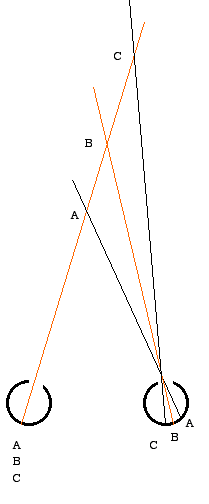 |
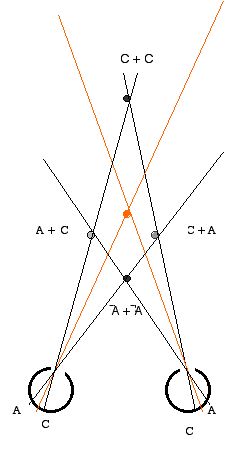 |
Better "picture" by making use of multiple perspectives, accepting/making use of "conflicts"
Ambiguity as fundamental in seeing (Hofstadter's Road Sign), sensory systems generally
Can be reduced by using multiple cues, not eliminated (a "useful" gap?)
Reality is such a funny concept ... Simone Emily
I think the idea of what reality is takes more thought than originally i had believed ... K. Smythe
What do we mean by "reality"?
Reality is a construction of the mind ... Jessica Krueger
it is not seeing something which causes us to believe in its existence, but rather belief in something which causes us to see it ... Molly Pieri
Just because we can’t detect all of reality or define reality doesn’t mean that a universal reality doesn’t exist ... Skye Harmony
before we dismiss reality because of every human's varying perception of it, remember that there is an actual reality, or certainty, that exists ... evanstiegel
Even if the brain is fabricating all of what we see or know, there is still reality because the mind/brain is real. Basically, what I'm trying to get at is, in order for there to be a reality, something has to be real......right? ... ptong
I have to question the usefulness of defining a “true” reality when, well, there is no truth ... EB Ver Hoeve
“real” is only a best “guess,” a piecing together of diverse and simultaneous input to create a tapestry that is “reality.” It seems there is no one, uniform reality, as such ... Sophie F.
the things we tend to accept as “real” are those things that are constructed in the same way by everyone’s brains ... Caitlin Jeschke
What is the I-function doing?
I believe this return to where we started only validates our initial claim and allows us to continue on by continually checking our foundation. Based on the Dickinson poem, what does "The Brain" refer to in our nervous system? Does Dickinson mean the I-function? ... cheffernan
when someone reads a sentence that contains a typo (such as a spelling error or a repeated word), they often don’t notice the typo.The eyes are assumedly detecting each letter correctly, so it must be the I-function that compares the input to previous remembered input and fixes the typo ... Skye Harmony
With respect to the "I" function, could it possibly play a part once we have become aware of both images in the skull/woman picture for example? ... Margaux Kearney
I-function may somehow personalize the experience of sight and give it context, layers and meaning ... Sophie F.
The I-function of the first person analyzes and describes to another person how the first person’s nervous system interprets something, and this verbalization allows the I-function of the second person to internalize this different way of interpreting something. I think that through this process of sharing by employing the I-function to look at what is going on internally, experience can be understood as something more than just an “ambiguous interpretation.” ... Maggie Simon
[Reality is] a construction or partially constructed by the I-function ... K. Smthe
See class discussion notes for more on "reality' and the I-function
This is not yellow |
or
When is red not red?
Physical "reality"
- Light consists of photons, intensity ~= number of photons
- Photons come in different wavelengths
- "White" = mix of photons of different wavelengths - alternate - alternate
- rainbow colors correspond to photons of different wavelengths
- colors of objects reflect absorption/reflection
- Retina - photoreceptors (two photosystems in humans, scotopic/photopic)
- Rods/cones and photopigments (alternate)
- dark adaptation
- Purkinje shift
- Trichromatic vision
- Color mixing(alternate)
- Land's color constancy ... more ... alternate
Lessons from color and ...
- "color" is a function of brain, not of physical reality
- Add color contrast, like brightness contrast
- Does a tree falling in the woods make a sound if no one is there?
- perception is different in different organisms (Goldsmith, Scientific American, July 2006)
- Most vertebrates have four cone pigments
- Most mammals have two
- perception different in different people
- Color "blindness" (alternate)
- Human tetrachromacy
- what is "real"? does it matter?
- what is "normal"?, the issue of "Culture as Disability"
- multiple perspectives advantageous? generative?
- sensory info, like motor output, coded across populations
- brain creates "platonic ideals" - "categories" which "work"
- a "gap" between the "physical" and the "mental"?
- allows creation of things which don't exist in physical reality - non-spectral colors
- is all done without the I-function
- there is a difference between knowing how to do something and EXPERIENCING doing something - a "crack"?
another hint about the existence of and role of the I-function?
relates to The Content and Epistemology of Phenomenal Belief, by David Chalmers, and Vision in a Complete Achromat, written by a vision scientist.
29 April
"Reality" is ...
It’s a challenge to separate real reality from fake reality ... Paul Bloch
Why differentiate at all? ... the very phrase “real reality” makes me itch. “Real” is relative—subjective, and I have a hard time basing the sum of my studies on the essence of "reality" and what it means to be "real" on a body of subjective data ... nasabere
Perhaps recognition that perceived reality is not the same for everyone (or for every I-function) is MORE REAL than the perceived reality itself! ... Jackie Marano
objective, collective, subjective ... Molly Pieri
eliminative ... PG
the interesting question left to consider is how the 3 interplay ... Anna G.
an individual who has lived a sheltered life would not be exposed to the realities of issues such as racism. Therefore when this individual may read or hear about the issue of racism, or people's encounters with a 'racist'--this sheltered individual has a myopic vision and therefore may not necessarily believe that such a concept exists in the world ... mkhilji
How is “self” defined? Is self then just another perception, a construction of the nervous system? ... Sophie F.
All three of the realities discussed come to us and are interpreted by our brains; they are thus all subjective and subject to the same error as a "private" reality ... Jessica Krueger
reality is always an hypothesis ... Rica Dela Cruz
The problem with believing in such a relativistic world is that there is no ultimate value system against which we can hold people accountable ... Angel Desai
we have formed language that we agree upon, we have sophisticated communication system and have found a way to line up our realities so that we can connect to other who exist in our reality, and presumably they feel they can connect to us ... K. SmytheWe have great power in our ability to change our realities because it means that we can conceive of a world around us irregardless of what the nervous system senses of that world. Thus, the I-function allows us the ability to try out theories about those parts of the world that we can not actively sense ... Maggie Simon
I think the amazing thing is that anyone, at anytime, is capable of altering someone else’s reality ... EB Ver Hoeve
The picture in the head always an hypothesis, checked and rechecked ... ? The sky ... and the self ... and reality always an hypothesis? Where is the picture in the head, and what does all this have to do with the I-function/story teller? Could that be the doubter, the entertainer of previously unconceived alternatives? "reality" created by the story teller as a stimulus for checking?
- Disconcerting ... but also liberating?
- individual creativity
- value of interpersonal sharing
The bipartite brain: where is the picture in the head? the I-function/story teller?
Multiple ganglion cell types - frog
- contrast and color opponency
- multiple samples
- motion
Retinal projections ... another ... another
- multiple targets
- midbrain
- thalamus -> striate cortex
- different, parallel functions
Moving on to neocortex
Remembering some relevant comparative neuroanatomy - neocortex as parallel to rest of nervous system
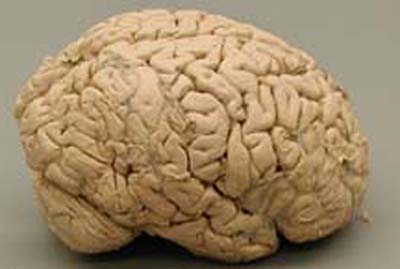 |
 |
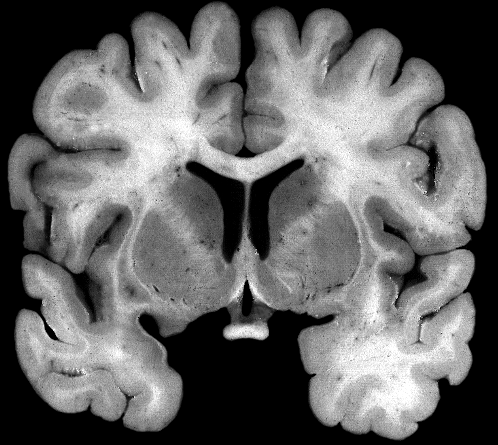 |
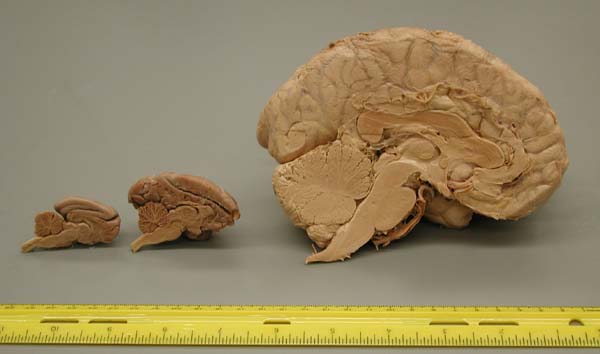 |
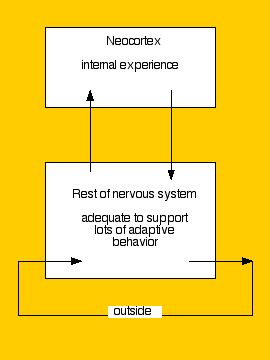 Visual Cortex - binocular convergence, altered "feature" detection, columnar organization, topographic organization
Visual Cortex - binocular convergence, altered "feature" detection, columnar organization, topographic organization
- Picture in head not in striate cortex
- parallels to topographic organization in motor cortex
- laterality re what looking at rather than re "self"
- unlike picture in head, representation in visual cortex moves when eyes move
- Color and motion dissociable
- Partial color deficits
- motion blindness
- face blindness
- Distributed "picture in head"
Blindsight and its implications - Don't NEED "picture in head"
- What IS "picture in head" for?
- internal experience
- Self as object
- Bipartite brain (as also seen from motor side)
- I-function ("story teller"?) in neocortex? constructed ("story"), testable, reconceivable, "imaginary" and hence re-imaginable
 Lessons from sensory side ...
Lessons from sensory side ...
- distributed systems
- ns "creative", "reality" an hypothesis rather than a touchstone?
- distinction between responding and experiencing, I-function/story teller
- I-function/story teller relates to neocortex?
- picture in head = pattern of activity in neocortex, thoughts/ideas?
Further evidence for a bipartite architecture in other realms - generalized control mechanisms
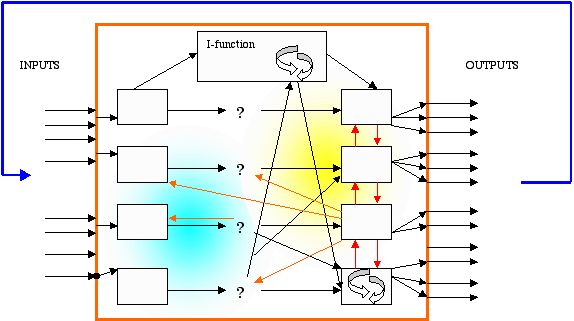 "generalized control mechanisms"
"generalized control mechanisms"
- wide spread changes of state
- pharmacological involvement
- degree of autonomy
- more on independence from I-function, on expectation generation
- more on I-function ("story teller") localization/independence
- human behavior without an I-function
- interplay of unconscious and I-function (story teller) to yield "self"

|

|
- pain as after the fact in re movement
- significant/communicable independent of I-function/story teller
- body language
- dementia and the unconscious
- implicit vs explicit memory (story?)
- contributory to adaptive thought
- Damasio
- in practice
- usable to develop/share more elaborate stories of what might be
Self - distributed, interaction of unconscious and I-function/story teller
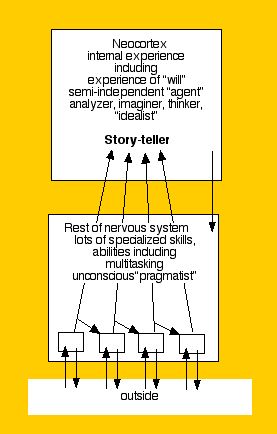
- number of variables handled
- use of 3D space, time
- use of "reality"
- coherence
- story vs summary of experience, implicit vs explicit memory, memory, history, time as story
-
- An outside /inside loop and an unconscious/story loop
- Conflict, generativity
- Free will
- agnosias
- parietal cortex - hemifield neglect
- frontal cortex - executive function, difficulty generating alternatives?
- split brain - multiple stories
- distributed story teller
- bilateral assymetry
- left brain vs right brain, unconscious vs story teller?
- right brain more directly related to unconscious?
Human experience, of self and of world, a "story"
Combination of unconscious and story gives not only ability to respond creatively but to create deliberately
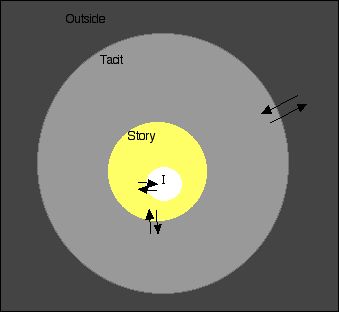
|
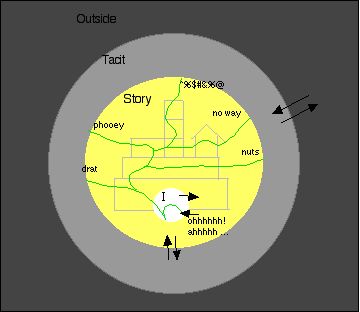 |
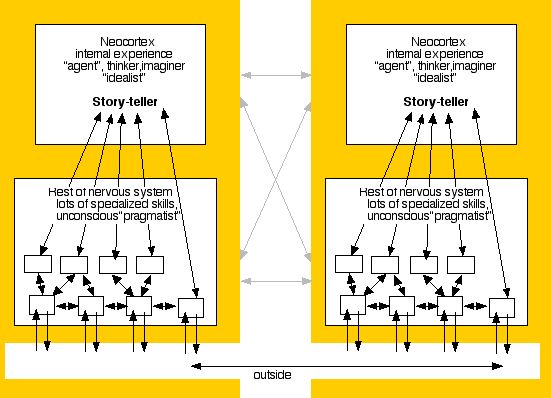
|
|
- I-function a part of story teller
- Creativity the way out of the box/determinism
- Exploring AND story creating
- Revisable self
- Revisable reality
- Culture
- Conflict
- Benefits of story sharing
- New approaches to "mental health"?
- New approaches to education?
- New forms of social organization generally?
Bottom line of story of brain=behavior:
- Believe in where one is, has come from (including genes)
- Challenge self/others, dream/imagine/create
- Share stories
- Repeat over and over again
I am, and I can think, therefore I can change who I am" ...
and what I find around me
Thanks for your contributions to our collective story telling, including my own. Your thoughts about where we started, have gotten to, might go in the future in the forum ...
To be continued



Comments
Post new comment